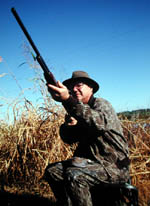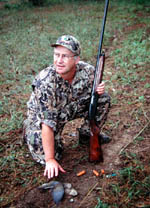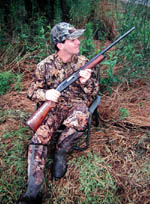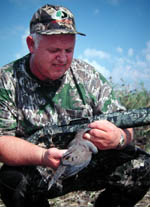
|
Features
|
|
|
|
Books
|
|
|
|
Fun & Games
|
|
|
|
Contact Us
|
|
|
John's Journal... Entry 211, Day 2
SECRETS TO TAKING MORE DOVES WITH TONY ROSETTI
Three More Secrets To Taking More Doves
 EDITOR'S
NOTE: Tony Rosetti not only has the reputation
in years past as one of the nation's best shots but also has proved his
prowess with a shotgun in national and international competitions. He
was the United States International World Champion in1969, 1971 and 1972;
the National Skeet-Shooting World Champion, an aggregate of all four gauges
.410, .28, and .12, in 1970 and 1972; the World Champion in 1972 in .12
gauge and .410 gauge; the last person to win three of the five World Gauge
Championships; a member of the Pan-American Games Gold Medal Team in 1971;
the Silver medal individual winner in 1971; a member of the 1972 U.S.
Olympic Shooting Team; and the past winner of the Mississippi State Championship
and many other championships and big-gun shoots.
EDITOR'S
NOTE: Tony Rosetti not only has the reputation
in years past as one of the nation's best shots but also has proved his
prowess with a shotgun in national and international competitions. He
was the United States International World Champion in1969, 1971 and 1972;
the National Skeet-Shooting World Champion, an aggregate of all four gauges
.410, .28, and .12, in 1970 and 1972; the World Champion in 1972 in .12
gauge and .410 gauge; the last person to win three of the five World Gauge
Championships; a member of the Pan-American Games Gold Medal Team in 1971;
the Silver medal individual winner in 1971; a member of the 1972 U.S.
Olympic Shooting Team; and the past winner of the Mississippi State Championship
and many other championships and big-gun shoots.
 Point
And Look At The Same Place At The Same Time: Rosetti believes most people
look at doves with their eyes but don't point their guns in the same direction
as they have focused their eyes. They bring their shotguns to their shoulders
and follow the birds with their eyes. As they track the birds with their
eyes, they keep their gun barrels down until they want to shoot, which
causes hunters not to have the barrels of their guns pointed at the doves
when they shoot.
Point
And Look At The Same Place At The Same Time: Rosetti believes most people
look at doves with their eyes but don't point their guns in the same direction
as they have focused their eyes. They bring their shotguns to their shoulders
and follow the birds with their eyes. As they track the birds with their
eyes, they keep their gun barrels down until they want to shoot, which
causes hunters not to have the barrels of their guns pointed at the doves
when they shoot.
"The first thing you must do when you see a dove is to understand where your barrel is in relationship to the dove," Rosetti explains. "Once you spot the bird, make sure you have the barrel pointed at the bird. Often a dove hunter looks at a dove and then brings his barrel to the dove. Instead, to sight and aim, look at the barrel first. Then bring the barrel to the dove, and pass the dove with the barrel. Although this suggestion may sound simple, if your barrel's not pointing where your eyes are looking, you can't shoot accurately. Practice looking at the bead on the barrel and swinging the barrel behind, through and past the dove. Once you have the bead and the dove in your sight picture, then and only then do you think about taking the shot."
 Utilize
The Lead Best For You: Most dove hunters use two different types of leads.
With the sustained lead, you hold your barrel out in front of the bird
during the aiming process. When you see what you believe to be the proper
distance between the end of the barrel and the dove, then you pull the
trigger. But as Rosetti reports, "The second type of lead, the swing-through
method, is the lead I prefer. I come from the rear of the dove, swing
past the bird and pull the trigger when I see daylight between my barrel
and the dove. No matter which lead you like, you must continue to swing
the gun after you squeeze the trigger. You can't just swing past the dove,
and then when you're out in front of it, stop the movement of the gun
and pull the trigger. If you do, you'll be shooting behind the bird, because
the bird keeps on flying forward."
Utilize
The Lead Best For You: Most dove hunters use two different types of leads.
With the sustained lead, you hold your barrel out in front of the bird
during the aiming process. When you see what you believe to be the proper
distance between the end of the barrel and the dove, then you pull the
trigger. But as Rosetti reports, "The second type of lead, the swing-through
method, is the lead I prefer. I come from the rear of the dove, swing
past the bird and pull the trigger when I see daylight between my barrel
and the dove. No matter which lead you like, you must continue to swing
the gun after you squeeze the trigger. You can't just swing past the dove,
and then when you're out in front of it, stop the movement of the gun
and pull the trigger. If you do, you'll be shooting behind the bird, because
the bird keeps on flying forward."
 Shoot
Trap, Skeet And Sporting Clays: "By shooting trap, skeet and sporting
clays, you learn how to continue to swing past the target and make the
proper follow-through to shoot correctly," Rosetti said. "Once your mind
learns how to see the proper lead and to continue the swing-through, then
leading and shooting doves will become automatic and much easier for you.
If you're serious about your dove shooting, go to a trap, a skeet or a
sporting-clay range. Have a qualified instructor watch you shoot. In 5
to 10 minutes, he'll be able to see the mistakes you're making and help
you drastically increase your ability to shoot doves more proficiently."
Shoot
Trap, Skeet And Sporting Clays: "By shooting trap, skeet and sporting
clays, you learn how to continue to swing past the target and make the
proper follow-through to shoot correctly," Rosetti said. "Once your mind
learns how to see the proper lead and to continue the swing-through, then
leading and shooting doves will become automatic and much easier for you.
If you're serious about your dove shooting, go to a trap, a skeet or a
sporting-clay range. Have a qualified instructor watch you shoot. In 5
to 10 minutes, he'll be able to see the mistakes you're making and help
you drastically increase your ability to shoot doves more proficiently."
TOMORROW: MORE DOVE-HUNTING SECRETS
Check back each day this week for more about SECRETS TO TAKING MORE DOVES WITH TONY ROSETTI ...
Day 1 - What Rosetti Knew
That I Didn't
Day 2 - Three More Secrets To Taking More
Doves
Day 3 - More Dove-Hunting Secrets
Day 4 - More Secrets That Will Help You Dove
Hunt Successfully
Day 5 - Rosetti's Safety Tips and Equipment
Recommendations